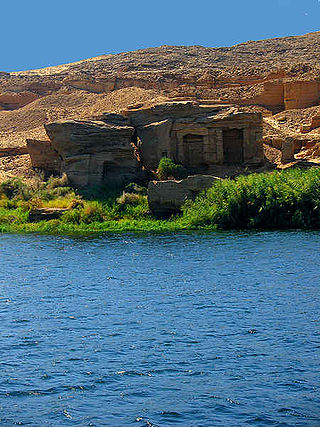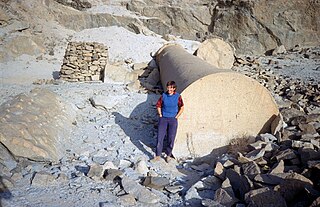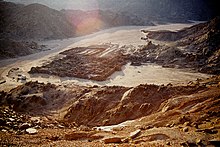
Hieratic is the name given to a cursive writing system used for Ancient Egyptian and the principal script used to write that language from its development in the third millennium BC until the rise of Demotic in the mid-first millennium BC. It was primarily written in ink with a reed pen on papyrus.
Claudius Claudianus, known in English as Claudian, was a Latin poet associated with the court of the Roman emperor Honorius at Mediolanum (Milan), and particularly with the general Stilicho. His work, written almost entirely in hexameters or elegiac couplets, falls into three main categories: poems for Honorius, poems for Stilicho, and mythological epic.

Dendera, also spelled Denderah, ancient Iunet 𓉺𓈖𓏏𓊖 “jwn.t”, Tentyris,(Arabic: Ewan-t إيوان-ة ), or Tentyra is a small town and former bishopric in Egypt situated on the west bank of the Nile, about 5 kilometres (3 mi) south of Qena, on the opposite side of the river. It is located approximately 60 kilometres (37 mi) north of Luxor and remains a Latin Catholic titular see. It contains the Dendera Temple complex, one of the best-preserved temple sites from ancient Upper Egypt.
The Meshwesh was an ancient Libyan Berber tribe, along with other groups like Libu and Tehenou/Tehenu.

The Kharga Oasislit. 'the outer'; Coptic: (ϯ)ⲟⲩⲁϩ ⲛ̀ϩⲏⲃ(di)wah enhib, "Oasis of Hib", (ϯ)ⲟⲩⲁϩ ⲙ̀ⲯⲟⲓ(di)wah empsoi "Oasis of Psoi") is the southernmost of Egypt's five western oases. It is located in the Western Desert, about 200 km to the west of the Nile valley. "Kharga" or "El Kharga" is also the name of a major town located in the oasis, the capital of New Valley Governorate. The oasis, which was known as the 'Southern Oasis' to the Ancient Egyptians, the 'outer' to the Greeks and Oasis Magna to the Romans, is the largest of the oases in the Libyan desert of Egypt. It is in a depression about 160 km long and from 20 km to 80 km wide. Its population is 67,700 (2012).

The Eastern Desert is the part of the Sahara desert that is located east of the Nile river. It spans 223,000 square kilometres (86,000 sq mi) of northeastern Africa and is bordered by the Nile river to the west and the Red Sea and Gulf of Suez to the east. It extends through Egypt, Eritrea, Sudan and Ethiopia. The Eastern Desert is also known as the Red Sea Hills. The Eastern Desert consists of a mountain range which runs parallel to the coast, wide sedimentary plateaus extending from either side of the mountains and the Red Sea coast. The rainfall, climate, vegetation and animal life sustained in the desert varies between these different regions. The Eastern Desert has been a mining site for building materials, as well as precious and semi-precious metals, throughout history. It has historically contained many trade routes leading to and from the Red Sea, including the Suez Canal.

The Blemmyes were an Eastern Desert people who appeared in written sources from the 7th century BC until the 8th century AD. By the late 4th century, they had occupied Lower Nubia and established a kingdom. From inscriptions in the temple of Isis at Philae, a considerable amount is known about the structure of the Blemmyan state.

Jean-Yves Empereur is a French archeologist. He studied classic literature in the University Paris IV Sorbonne.

The stone quarries of ancient Egypt once produced quality stone for the construction of decorative monuments such as sculptures and obelisks. These quarries are now recognised archaeological sites. Eighty percent of the ancient quarry sites are in the Nile valley; some of them have disappeared under the waters of Lake Nasser and some others were lost due to modern mining activity.

Georges Albert Legrain was a French Egyptologist.

The Via Hadriana was an ancient Roman road established by the emperor Hadrian, which stretched from Antinoöpolis on the River Nile to the Red Sea at Berenice Troglodytica (Berenike). Hadrian had founded Antinoöpolis in memory of his presumed lover, the youth Antinous, who had drowned in the Nile. The Via Hadriana was finished in 137 AD. Traces of the road line were noted by Couyat (1910) and Murray (1925) who recorded the sites of several small mansiones in the southern part of the road. However, few were in the north and none at all were on the west-east stretch between Antinoöpolis and the coast. Many of these road stations had fortified watering points (hydreumata), which are likely to have given their name to the Hadhramaut on the other side of the Red Sea.
Jean Clédat was a French Egyptologist, archaeologist and philologist. He became a resident at the Institut Français d'Archéologie Orientale. At various times, Clédat's expeditions was sponsored by Compagnie universelle du canal maritime de Suez, the Supreme Council of Antiquities, the Comité, and the Institut itself.
Hélène Cuvigny, Directeur de recherche au CNRS, is a French papyrologist, specialist of the eastern Egyptian desert in Roman times.

Jean Bingen was a Belgian papyrologist and epigrapher, specialized in Greek and Roman history and civilizations, especially ancient Egypt, economic history of Ptolemaic Egypt, Greek papyrology and epigraphy, Greek and Roman archaeology, Greek and Latin epigraphy, Greek (Thorikos) and Roman numismatics, Greek philology and literature (Menander).

Marijke van der Veen, is a Dutch archaeobotanist and Emeritus Professor of Archaeology at the University of Leicester.
Valerie Maxfield FSA is a Roman archaeologist and emeritus Professor of Archaeology at the University of Exeter. She is a specialist in the archaeology of the Roman army and frontiers, and edited the Proceedings of the Devon Archaeological Society until December 2020.

Mons Porphyrites is the mountainous site of a group of ancient quarries in the Red Sea Hills of the Eastern Desert in Egypt. Under the Roman Empire, they were the only known source of the purple "imperial" variety of porphyry. They were exploited between the 1st and 5th centuries AD. The other imperial quarries in the Eastern Desert were Mons Claudianus, Mons Ophiates and Tiberiane. These four quarries were probably under a unified administration, since the same procurator metallorum is found in more than one.

Sennefer was an Ancient Egyptian official with the title Servant in the Place of Truth at the end of the 18th Dynasty. He is mainly known due to his unlooted burial found in 1928 by excavations under Bernard Bruyère at Deir el-Medina. The burial chamber of Sennefer was found within the tomb of the servant at the place of truth Hormes. The small chamber contained the inscribed coffins of Sennefer and his wife Nefertiti. Both were found wrapped in linen. Sennefer was also adorned with a mummy mask. He had a heart scarab and was adorned with a pectoral. On his coffin was placed a painted piece of cloth, showing Sennefer before an offering table. Furthermore, the burial contained different types of furniture, including a bed, a box, a head rest and several pottery as well as stone vessels. The burial of a child in an undecorated box was found, too. Two shabti figures are datable by style to the end of the 18th Dynasty.

Walter Eric Harold Cockle FSA was a historian of the ancient world at University College London. He specialised in papyrology and is particularly known for his work on the Oxyrhynchus Papyri and his many entries for The Oxford Classical Dictionary. He produced a new edition of Euripides' partly-lost tragedy Hypsipyle based on a meticulous re-examination of the surviving papyrus fragments and was elected a fellow of the Society of Antiquaries of London in 1987.
















